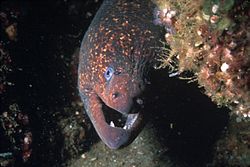Diet
The California moray is thought to be primarily piscivorous, and appears to specialize in the kelp bass, Paralabrax clathratus. [13] However, they are opportunistic predators whose diet also consists of invertebrate prey such as octopuses, lobsters, other California morays, and red rock shrimp. [3] [14]
Feeding behavior
The California moray is the apex predator in the reef, its natural habitat, as they have few natural predators and face no intense competition for prey. They are thought to be nocturnal hunters due to their elusiveness in the daytime. [15]
Although many fishes have highly expandable skulls and can use suction feeding to capture prey, the fused skulls of morays prevents this. [8] Instead, California morays (like other moray eels) have a special set of pharyngeal jaws that allows prey to be transported from their mouths into their throats. These pharyngeal jaws look like miniature versions of the oral jaws and are more mobile than pharyngeal jaws in the other fishes. [16] As an additional aid to prey transport, they have a set of depressible teeth in the roof of their mouths that fold upward as prey is swallowed. [17] Despite the bite force of the California moray varying from 32N and 467N, morays do not exhibit a preference for certain food types based on their relative bite force. [18]
The California moray's prey manipulation behaviors, including consumption and transportation, also do not vary depending on prey type. However, the time spent on prey manipulation behaviors increases as prey size increases. [19] The California moray spends more time feeding as the size of the fish and cephalopods increases. However, when consuming a cephalopod, the California moray spends a greater proportion of time on transportation than feeding. Moreover, prey size increases with the size of the individual California moray. [20] When it comes time for the moray to feed on a cephalopod, like an octopus, the cephalopod will resist by latching on the head of the moray with its tentacles. To counter the cephalopod, the moray will twist and rotate its body so the tentacles can unhinge off the body so the moray can eat the cephalopod. [21] As a California moray grows, its prey becomes larger and it stops consuming smaller organisms.
California moray
California moray
California moray




